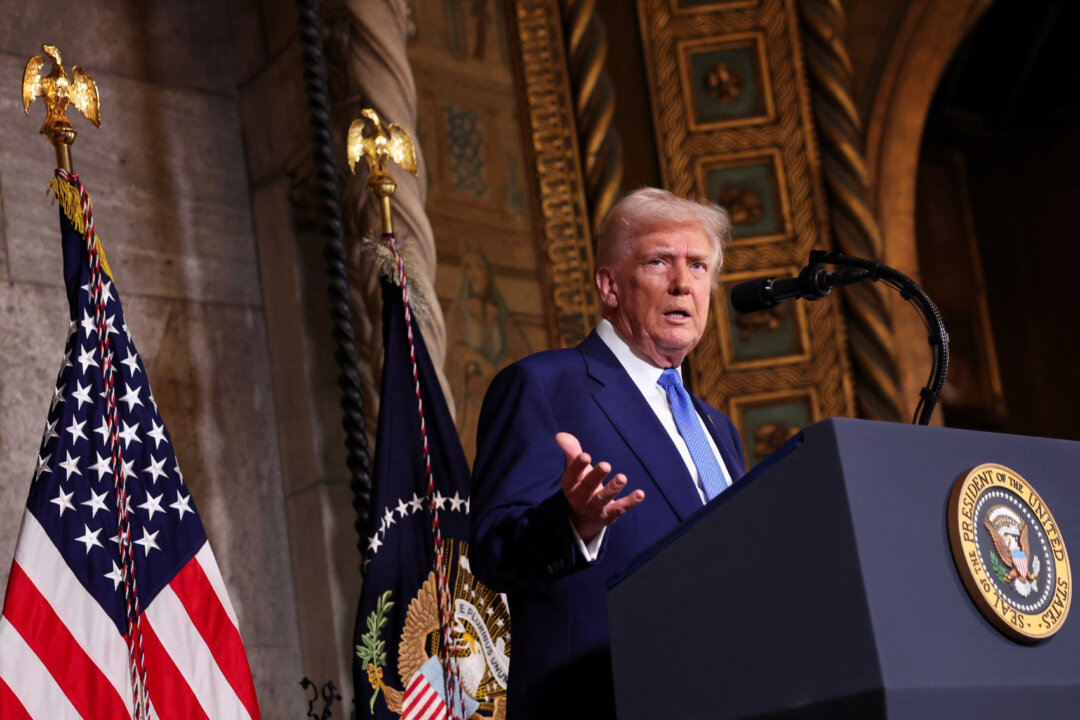The proposal was first floated by businessman James Fishback, who called it a ‘DOGE dividend.’
President Donald Trump said on Feb. 19 that he is considering having his administration return 20 percent of the savings identified by the Department of Government Efficiency (DOGE) to U.S. citizens.
Trump also said he would consider using another 20 percent of the savings to pay down the federal government’s debt. The comments came during a summit hosted by Saudi Arabia’s sovereign wealth fund in Miami, Florida, with global financiers and tech leaders.
“There’s even under consideration a new concept, where we give 20 percent of the DOGE savings to American citizens, and 20 percent goes to paying down debt,” Trump said.
Businessman James Fishback originally made the proposal on Feb. 18 in a post on the social platform X, calling it a “DOGE dividend.”
“President Trump and @ElonMusk should announce a ‘DOGE Dividend’—a tax refund check sent to every taxpayer, funded exclusively with a portion of the total savings delivered by DOGE,” Fishback, the CEO of Azoria Partners investment firm, wrote.
DOGE leader Elon Musk said he would discuss the idea with Trump, responding to Fishback in an X post, “Will check with the president.”
According to Fishback’s analysis, if DOGE succeeded in the significant task of cutting federal spending by $2 trillion, 20 percent, or $400 billion, returned to American taxpayers would be roughly $5,000 for each of the country’s 79 million tax-paying households.
Preston Brashers, a tax policy research fellow at the Heritage Foundation, celebrated DOGE’s efforts but called the proposal a “bad idea.”
“The dividend we get from slashing spending is that it brings inflation into check. But if the government sends out stimmy checks, inflation will come back with a vengeance,” Brashers wrote in a post on X.
Fishback said in his proposal that the DOGE dividend checks would not be inflationary because “tax-paying households are more likely to save (not spend) a transfer payment like the DOGE Dividend as consumption is a lower share of their income.”
He cited a 2019 CNBC survey that found that if given an unexpected $5,000 bonus, a combined 71 percent of Americans would first use the money to pay off debt, save it for short-term expenditures or emergencies, or invest it for long-term goals like retirement or college.
Speaking from aboard Air Force One on Wednesday night, Trump said he loved the 20 percent DOGE Dividend idea.
“I think it’s a great idea. It could be a lot,” Trump said. “It could also give the taxpayer incentive to go out and report things.”
Musk’s advisory commission has targeted hundreds of small contracts that it says equal $8.5 billion in savings, according to Reuters’s analysis of data provided by the DOGE team. The analysis noted that the total is a fraction of what the federal government pays contractors every year.
For example, Musk’s aerospace company, SpaceX, alone has roughly $22 billion in contracts with the U.S. government.
Douglas Holtz-Eakin, a former Republican director of the Congressional Budget Office (CBO), said last week that the agencies and programs targeted by DOGE so far only account for a small fraction of the overall federal budget, which the CBO projects to reach $7 trillion this fiscal year.
Bill Hoagland, a former Republican staffer and director of the Senate Budget Committee for more than 20 years, accused DOGE’s cost-cutting efforts of being motivated by “philosophical and ideological differences conservatives have with the work these agencies do,” Hoagland said.
Trump and Musk have said that DOGE’s work is necessary, and that its cuts at various federal agencies are a good-faith effort mandated by American voters to save their tax dollars from “widespread fraud and abuse.”
Reuters contributed to this report.

